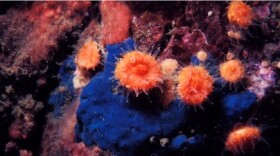It would be a bit of a stretch to call zoologist John Fleckenstein a beginner. He recently retired from a long career as a kind of wildlife detective. He worked with Washington State’s Natural Heritage Program, looking for and studying the behaviors of all kinds of rare creatures.
But he was relatively new to the Pacific Northwest in the late 1990s. He had just relocated from the mid-west and wanted to get out and explore. He needed to “learn the butterflies” here. And he had to rely on the help of others who had deeper knowledge of that field when he and a colleague embarked on a project to establish baseline data for the inventory they were creating.
They were working to catalog local butterflies and other insects that thrive on plants in open spaces of the state.
“We decided we needed a systematic inventory of prairies, especially targeting prairie butterflies up and down the Puget Trough,” he says.
Fleckenstein was drawn to the rugged beauty of the San Juan Islands. He collected a bunch of butterflies on a beach near American Camp, a National Historical Park on the south end of San Juan Island, in the heart of the Salish Sea.
As it turned out, that work brought in an extremely rare specimen.

The Island Marble Butterfly was thought to be extinct until 1998, when Fleckenstein netted two of these small white butterflies, which get their name from the bright green camouflage pattern on the underside of their wings.
The last prior recorded sighting of them was in 1908.
“So obviously they’d been out there the whole time. The previous records were all from Vancouver Island, British Columbia. So, they may have existed up there for some time,” Fleckenstein says.

“It’s just that nobody had been out there looking for them, at the time, when they could find them.”
"What Is This?"
But it was more than just being in the right place at the right time.
If it weren’t for the keen eye of his colleague Ann Potter, who still works as a conservation biologist for the Washington Department of Fish and Wildlife, Fleckenstein might have missed it.
“We were confused,” says Potter. “We had no idea what it could be. I even thought that his samples were mislabeled for a while.
“My thoughts were, 'I don’t know what this is. What is this?'" says Anne of the moment she first saw them. That was the beginning of a continuing mystery about how this species eluded documentation for a century.
In this story, Fleckenstein explains how luck and having a beginner's mindset played a role in the re-discovery of the species.
The Island Marble Butterfly is now on its way to being listed as an Endangered Species under federal law, the highest protection available.













